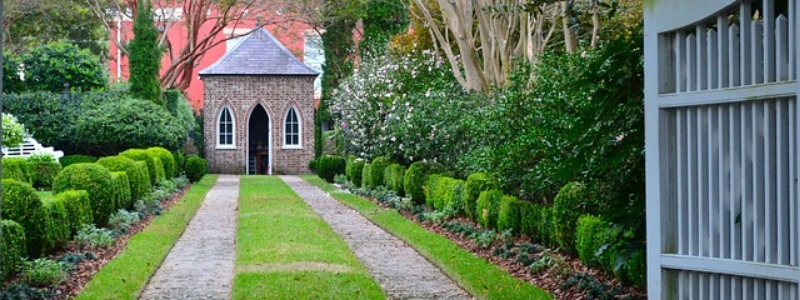The “Holy City” is the nickname of this American city due to the number of churches of all denominations. They are also used by local residents to help give directions.
One of the most important churches in Charleston is St. Mathews Lutheran on King Street, facing Marion Square. Its importance has to do with its height. This pretty pink church has the tallest spire in the city – 297 feet – and is the tallest building. When the City Fathers agreed to restrict building heights, this spire was designated to be the limit.
The square is named for General Marion. During the Revolutionary War, the British called him the Swamp Fox because he and his men fought from the nearby swamps. After the war, he became a State Senator and was a member of the State Constitutional Convention.
On the top of the column in Marion Square is the statue of Vice-President John C. Calhoun.
Across the square, facing St. Mathews is the Citadel Square Baptist Church on Meeting Street. It is a pretty primrose yellow and white confection.
To the left up Meeting Street when facing the yellow and white church, is the Visitor Information Center. As it was once a railroad station, it is easy to see. In here there are leaflets galore about the city, tours to book and, a most useful item – a ticket for the DASH trolley. These travel all over town and can be useful for preserving energy levels.
Church Street, as its name implies, has churches. For example, there is St. Philip’s Protestant Episcopal Church and graveyard. Its neoclassical arches are based on those at St. Martin’s-in-the-Fields in Trafalgar Square, London.
In the graveyard are Edward Rutledge (a signer of the Declaration of Independence), Charles Pinkney (a signer of the US Constitution), and the Hon. John C. Calhoun (a Vice-President of the United States). Also here is DuBose Heyward who wrote the book “Porgy” and who worked with George Gershwin on the libretto for the opera “Porgy and Bess”.
Another church on the street is the wonderful Victorian Gothic French Huguenot Church which is as white as a wedding cake and covered with spires and black finials.
These two churches form the directions to the Dock Street Theater with its gorgeous lacy wrought-iron balconies looking as if it should be in New Orleans; and the Thomas Elfe Workshop. This last, built prior to 1760, is a miniature of a Charleston “single house” and is fascinating to look through.
To find the Gibbes Museum of Art it is an amble into Cumberland Street and the circular Congregational Church.
Near the Gibbes Museum (Meeting Street) is St. Michael’s Protestant Episcopal Church where both George Washington and the Marquis de Lafayette worshipped. Also along this street is the First (Scots) Presbyterian Church.
There are some wonderful houses on the South and East Batterys that often appear in magazines and on postcards. The wealthy planters built their summer homes here to take advantage of the cooling sea breezes. Some of them are now B&Bs which are great for really romantic stays. Several houses in the city are open to the public.
An explanation about the Charleston Houses. Small ones are called one room, meaning one room wide while others can be two or even three rooms wide. The side of the house faces the street. There is a door to one side which opens onto the piazza (gallery) – which is on either the south or west side – and the front door is halfway along with that.
Each floor has a piazza with rooms opening onto it. As these houses were built before air conditioning was invented, the piazza and rooms opening into each other was the way of keeping cool air circulating. Incidentally, when on an upper floor piazza it is the height of Charleston bad manners to look off the north side into the neighbor’s back garden.
Charles is on America’s East Coast and can be reached on Interstates 26/526. The city also has an airport served by several airlines.
The Charleston CVB’s website has lots of useful information including the DASH shuttle.
While in Charleston don’t forget to go and visit the Plantations.
A couple of hours driving south (SR17/I-95/SR17) is another pretty city – Savannah, Georgia.
